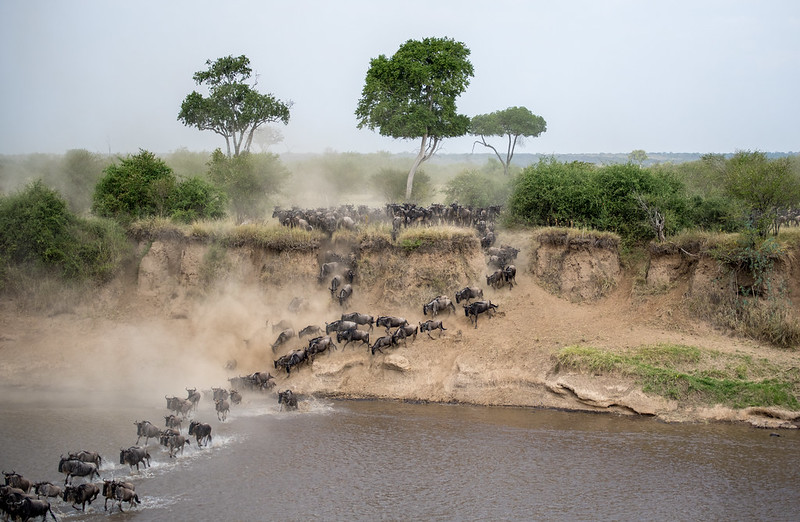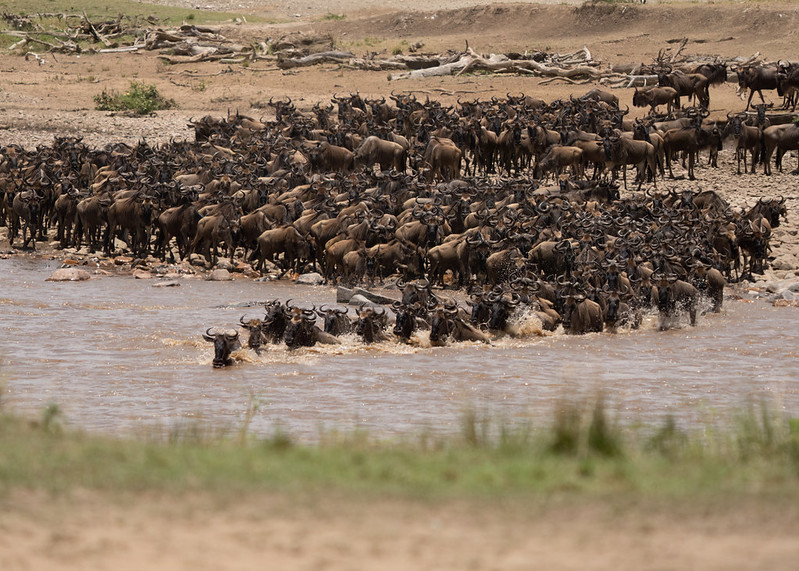The Wildebeests start arriving Kenya in June and by July- August, the entire plains of Mara have been occupied by the wildebeests, zebras and gazelles and its when mara crossing is in progress
Tsavo East & West National Parks In Kenya
Overview
Tsavo National Park is one of the largest and oldest national parks in Kenya, located in the southern part of the country. It’s divided into two sections: Tsavo East and Tsavo West, each offering unique attractions and experiences for visitors. The park is the largest national park in Kenya covering a total area of approximately 22, 812 square kilometers. Tsavo National Park attractions are the key factors/ things that have attracted a number of travelers coming in to the park to experience the uniqueness of Tsavo national park.

Related Kenya Safaris
Attraction Of Tsavo East
Tsavo East national park is one of the oldest and largest national parks in Kenya, located in the eastern part of the country. It forms part of the Tsavo Conservation Area along with Tsavo West National Park and the Chyulu Hills National Park.
Tsavo East National Park is situated in southeastern Kenya, covering an area of approximately 13,747 square kilometers (5,308 square miles). It is part of the larger Tsavo Conservation Area, which is one of the world’s largest wildlife conservation areas.
Tsavo East is renowned for its diverse wildlife, including elephants, lions, leopards, cheetahs, zebras, giraffes, buffaloes, hippos, crocodiles, and various species of antelopes. The park is also a haven for birdwatchers, boasting over 500 bird species. The park is characterized by diverse landscapes, including open grasslands, scrublands, semi-arid acacia woodlands, and the Galana River, which flows through the park, providing a lifeline for the wildlife
Attractions and Activities in Tsavo East National Park
Visitors to Tsavo East National Park can enjoy game drives, birdwatching, bushwalks, and photography. Some notable attractions within the park include the Mudanda Rock, Yatta Plateau (one of the world’s longest lava flows), Lugard Falls, and the Aruba Dam.
Mudanda Rock:
Mudanda Rock is a notable landmark within the park, offering panoramic views of the surrounding plains and waterholes. It’s an excellent spot for viewing wildlife, especially elephants.
Tsavo East National Park is a vital area for wildlife conservation and habitat preservation. Efforts are continually made to combat poaching, conserve natural resources, and protect the park’s diverse flora and fauna.
How to get to Tsavo East national park
The park is accessible by road from major cities and towns in Kenya, including Nairobi and Mombasa. The main gates to the park are Voi Gate, Manyani Gate, and Buchuma Gate.
Overall, Tsavo East National Park is a significant destination for wildlife enthusiasts, offering a chance to experience the beauty of Africa’s natural landscapes and its diverse wildlife.

Attraction Of Tsavo West
Tsavo West National Park is one of the prominent national parks in Kenya, located in the Coast Province of Kenya. It is part of the larger Tsavo Conservation Area, which also includes Tsavo East National Park and Chyulu Hills National Park. Tsavo West National Park is situated in the southeastern part of Kenya, covering an area of approximately 9,065 square kilometers (3,500 square miles). The park is characterized by diverse landscapes, including savannah grasslands, volcanic hills, lava flows, and the stunning Chyulu Hills.
Tsavo West is home to a rich variety of wildlife, including elephants, lions, leopards, cheetahs, zebras, giraffes, hippos, crocodiles, and numerous species of antelopes. The park is also known for its birdlife, with over 600 species of birds recorded. Notable features within Tsavo West National Park include the Mzima Springs, a series of natural springs that provide fresh water for the wildlife; Shetani Lava Flow, a massive expanse of volcanic rock; and the Ngulia Rhino Sanctuary, a protected area for the conservation of black rhinos.
Mzima Springs:
Mzima Springs is a major attraction within the park, known for its crystal-clear waters and underwater viewing points, offering a chance to observe hippos and fish underwater.
Activities:
Tourists visiting Tsavo West National Park can engage in a variety of activities, including game drives, guided walks, birdwatching, picnicking, and camping. Cultural visits to the nearby communities, especially the Maasai, provide insights into traditional ways of life.
Tsavo West National Park is part of a larger conservation effort to protect the biodiversity of the Tsavo ecosystem. Conservation initiatives focus on safeguarding wildlife and their habitats, combating poaching, and promoting sustainable tourism.
How to get there
The park is easily accessible by road from major cities like Nairobi and Mombasa. It has several gates for entry, including the Mtito Andei Gate, Chyulu Gate, and the Tsavo Gate.
Tsavo West National Park is a popular destination for both local and international tourists, offering incredible wildlife experiences and breathtaking natural beauty.
The two national parks are divided by the highway that crosses in the middle of the park running from Nairobi to the costal province in Mombasa. The combination of two national parks, has made it one of the best national parks in Kenya. The attractions from the two national parks, has given the best from both national parks thus creating a wider ranger of Tsavo national park attractions. Tsavo national parks include the following;
Wildlife Viewing:
Tsavo National Park is renowned for its diverse and abundant wildlife. Visitors can spot the “Big Five” (lion, elephant, buffalo, leopard, and rhinoceros) along with other animals like giraffes, zebras, antelopes, crocodiles, hippos, and a wide variety of bird species.
Mzima Springs:
Located in Tsavo West, Mzima Springs is a series of natural springs that provide a vital water source for the wildlife in the park. Visitors can view the crystal-clear waters and observe hippos, crocodiles, and a variety of fish from underwater observation points.
Shetani Lava Flows:
The Shetani Lava Flows are the remains of volcanic activity from centuries ago. The black, rugged landscape provides an otherworldly feel and is a great place for hiking and photography.
Ngulia Rhino Sanctuary:
Tsavo West is home to the Ngulia Rhino Sanctuary, a protected area where efforts are made to conserve and protect the endangered black rhinoceros. Visitors can learn about rhino conservation and may have the chance to see these magnificent creatures.
Yatta Plateau:
Yatta Plateau is one of the world’s longest lava flows, stretching for about 290 kilometers. It offers breathtaking panoramic views of Tsavo East and the Athi River.
Lugard Falls:
Located on the Galana River in Tsavo East, Lugard Falls is a series of rocky rapids and waterfalls. It’s a great spot for picnics and offers beautiful scenery.
Aruba Dam:
Aruba Dam in Tsavo East is a popular watering hole attracting a variety of wildlife, making it a prime spot for game viewing.
Birdwatching:
Tsavo National Park is a haven for birdwatchers, with over 500 species of birds recorded. Birdwatching enthusiasts can spot a wide array of colorful and unique bird species.
Rock Climbing and Hiking:
The diverse landscape of Tsavo provides opportunities for rock climbing and hiking. Exploring the cliffs and rock formations can be an exciting adventure for outdoor enthusiasts.
Cultural Heritage Sites:
Tsavo is rich in cultural history, and visitors can explore sites that showcase traditional Maasai culture and learn about the local communities residing near the park.
Exploring Tsavo National Park is an incredible experience, offering a blend of wildlife, stunning landscapes, and cultural insights that make it a must-visit destination for nature and wildlife enthusiasts.
Best Time To Visit
Best time to visits Tsavo national park
Despite the park being an all-round experience, Tsavo national park is best visited during the dry season characterized by little on no rainfall at all, from the month of June, October and January to February. The dry season offers the best chance to spot game compared to the wet season which is a bit challenging to drive through muddy park trails.
The best time to visit Tsavo National Park largely depends on your preferences and what you want to experience during your visit. Tsavo National Park, located in Kenya, is a popular destination known for its diverse wildlife, stunning landscapes, and opportunities for outdoor activities such as game drives, birdwatching, and hiking. The park is divided into Tsavo East and Tsavo West, each offering unique experiences.
- Dry Season (June to October):
This is generally considered the best time to visit Tsavo National Park. Wildlife is easier to spot as animals gather around water sources due to the dry conditions. The grass is shorter, improving visibility for game viewing. The weather is generally mild and pleasant.
- Wet Season (November to May):
The wet season is characterized by lush greenery and abundant water sources, providing a beautiful and scenic landscape.
Birdwatching is at its best during this time, as migratory birds arrive. The wildlife may be more dispersed due to the availability of water throughout the park. This season is great for photography due to the vibrant colors and dramatic skies.
- March to May (Long Rains):
The months of March to May are part of the long rainy season, and some roads in the park may become impassable. It’s not the most ideal time for wildlife viewing, but the landscape is exceptionally green and beautiful.
- June to October (Dry Season):
This is the peak tourist season due to the pleasant weather and excellent wildlife viewing opportunities.
Accommodation and tours might be in higher demand, so it’s advisable to book in advance.
Ultimately, the best time to visit Tsavo National Park depends on your preferences for weather, wildlife viewing, and the type of experience you seek. If you’re looking for prime wildlife viewing and pleasant weather, consider visiting during the dry season, particularly from June to October. However, if you enjoy lush landscapes and birdwatching, the wet season might be more appealing.
Accommodation facilities in Tsavo national parks.
The National Park has got a number of lodges both situated within and outside the park’s boundaries. The lodges range from budget, midrange to luxury lodges which include; Tsavo lodge Voi, Kudu Camo Tsavo East, Kilaguni Serena Safari Lodge among others.
How to get there
Request Quote
Fill in and send the safari request form, we shall respond as soon as we receive your message.
You can also reach us on Whats-app Number: +256753750983 for urgent requests.
Tour Highlights
- Day 1: Transferring from Nairobi to the Lake Nakuru
- Day 2: Lake Nakuru to Masai Mara National Reserve
- Day 3: A Full day in the Masai Mara
- Day 4: Transfer back to Nairobi
Why Book This Tour?
- Tour can depart on any day of the week.
- Tour can be customized
- Transportation in Landcruiser or minivan with pop-up for game viewing
- Suitable for solo travelers
Kenya National Parks
Masai Mara National Reserve
Read Our Reviews





